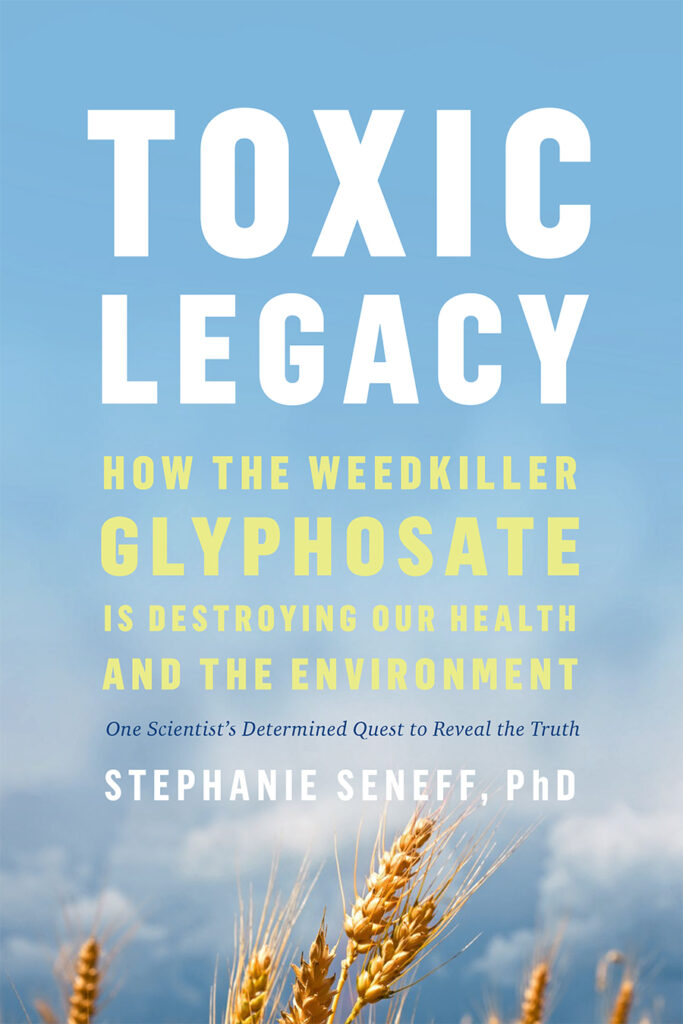
How the Weedkiller Glyphosate Is Destroying Our Health and the Environment”
By Stephanie Seneff
Chelsea Green Publishing, 2021
272 pages, hardcover, $24.95
“Toxic Legacy” isn’t Stephen King’s latest bestseller, but it may keep you up at night. Though complex at times, this biochemical treatise is convincing that glyphosate, an active ingredient in most Roundup herbicides, is poisoning all of us right this very second.
Stephanie Seneff is a somewhat unconventional voice on the topic of toxicity. She is senior research scientist at the Computer Science and Artificial Intelligence Laboratory of the Massachusetts Institute of Technology, but over the course of her long, illustrious career, she has enthusiastically and successfully hopped between disciplines. Seneff has studied everything from auditory processing and geophysics — she even worked on research to improve Siri’s and Alexa’s linguistic abilities — before landing somewhat serendipitously at the intersection of agriculture and public health.
Seneff explains that “Toxic Legacy” is the culmination of a decade of research — one that has led her to believe strongly that glyphosate is the cause of (or at least contributes to) many of the health and environmental ills we experience today.
She chooses to focus on the biochemical harm caused by glyphosate, which she shows is uniquely capable of wreaking havoc on life’s most fundamental components — including DNA and amino acids — based on its specific structure and makeup. Seneff’s writing style is chillingly direct. She goes through the human body systematically to point out the ways that glyphosate breaks down even the most basic processes at their molecular root, like how it can replace the amino acid glycine in many of our body’s essential proteins.
Seneff does her best to explain the science of glyphosate’s destruction, but she recognizes the challenge of the task. At times she almost begs the reader to see the more technical explanations through to their conclusion. She does an admirable job, peppering the drier bits with punchy metaphors to help the less scientifically minded reader along, but portions of the book may be confusing to those who fell asleep in their high school biology and chemistry classes.
Even if it takes a few tries for the science to sink in, the results are skin-crawling. As Seneff goes through and details the horrors of yet another way glyphosate can slowly infiltrate all of your body’s systems, from the brain to the gut, it’s hard not to flip to the end in search of solutions.
Seneff aims to keep hope alive, reminding the reader that many of the glyphosate changes are reversible. She cites studies about how consuming probiotics can reduce the negative impacts of antibiotics in infants’ guts, and how sulforaphane present in cruciferous vegetables has been shown to reduce the decay of brain cells. “Think of your health as a barge that’s been slowly heading out to sea in the wrong direction. It takes a lot to turn it around. It won’t happen overnight but it will happen.”
However, she loses the plot a bit in her final chapter. She goes on tangents about turning off cellphones at night to prevent disruption to human magnetic fields and the hidden harms of sunscreen use. She tries to bring it back to glyphosate each time but doesn’t always stick the landing. There’s no doubt Seneff has reasons just as detailed for voicing the potential harms of these things as she does for glyphosate, but it’s a disservice to shoehorn them in.
For readers looking for immediate action items, the conclusion of Seneff’s research may be unsatisfying: policy has to change and glyphosate has to be banned worldwide, as it already is in many European countries, for us to truly be able to avoid this toxin.
We may be getting there. On June 17, the United States Court of Appeals for the Ninth Circuit sided with the Center for Food Safety, farmworkers and conservationists by overturning a Trump-era Environmental Protection Agency decision that glyphosate is safe for humans and imperiled wildlife. Where this ruling leads remains to be seen, but after reading “Toxic Legacy,” I anxiously hope we move in the right direction.
Sam Schipani, Bangor, Maine
